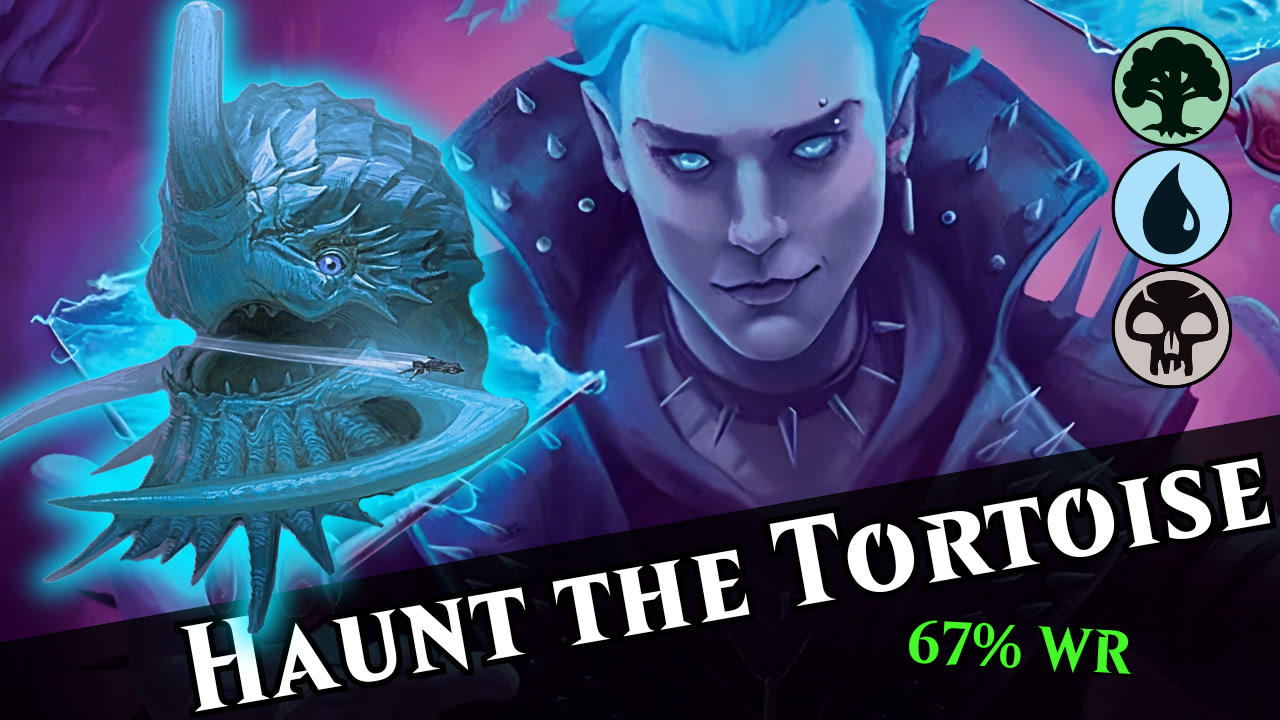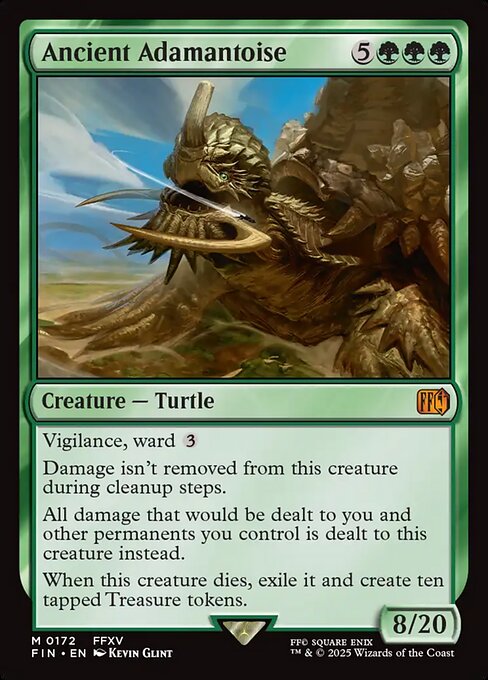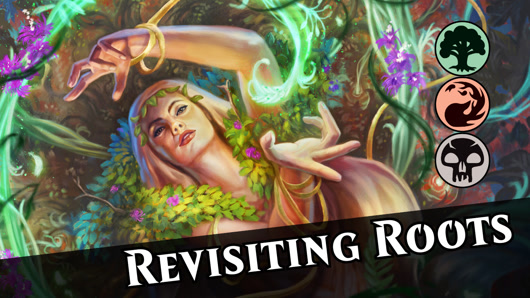If you're anything like me, a card like Ancient Adamantoise can't help but capture your imagination, and today I've decided to build around it, and I'm pretty happy with the results. As of this writing, I've played twelve matches with this beast and have an 8-4 record. Beyond just the numbers, though, the deck feels good for such a janky brew and definitely has the stopping power to help you climb the ladder.
The Primary Combo
Ancient Adamantoise is a goofy card in a lot of ways. On the one hand, it's twenty damage your opponent has to deal with before they can start hurting your face again, so it's almost like a second life total you pick up. Unfortunately, deathtouch creatures are very popular right now, especially in the mono-black decks, so it dies fairly quickly in those matchups. This was the primary reason why I chose to focus on the payoff you get when the tortoise dies rather than trying to reset the damage with something like Y'shtola Rhul or Scrollshift.
Our goal with this deck is to reanimate as many adamantoises as we can using Zombify or Valgavoth's Faithful, let them tank as much damage as they can for us, then die in a blaze of glory. Once our opponent thinks they've finally plowed through our defenses, we simply cast Haunt the Network with at least ten treasures online for a kill shot. If we're successful in getting at least two adamantoises to die this way, a single Haunt the Network can easily execute our opponent, but we also have a ton of mana and can spare a couple of treasures if we have to cast a second to finish the job.
The Setup
Like so many good late-game decks in Standard today, we need to ramp somehow and get the big turtles into our graveyard. Collector's Vault is fantastic for this as it spots us the treasure tokens and gives us a repeatable ramp engine. In game one, we can confidently discard our adamantoises or our one-of Rune-Scarred Demon for reanimation purposes, but the ramp the vault provides can also eliminate our need for our graveyard in games two and three if we suspect our opponent has pulled grave hate in from the sideboard.
Side note: Always assume they sideboard in graveyard hate. Most players do.
Goldvein Hydra is a shockingly powerful card and can perform double duty in this deck. If the game has dragged on and we just need some quick damage, we can sacrifice any treasures we have lying around to pump this thing immensely for an attack, and if it dies, it gives us back the treasure. It represents an alternate win con as well as early board presence. Sometimes you'll have to get a 2/2 or even 1/1 Goldvein Hydra as an early speed bump against aggro, but that doesn't feel bad because it ramps you and buys you time when it dies.
Like the hydra above, Lumbering Worldwagon is a ramp piece that can be a sneaky threat our opponents will have to respect. I've been playing this card a lot since the bans and think it's low-key, one of the best three-drop ramp spells available. I know Overlord of the Hauntwoods and Summon: Fenrir are also great cards, but the sheer stopping power of the Worldwagon and the fact that it dodges sorcery-speed interaction cannot be overstated. It's also an artifact, so Haunt the Network counts it.
The Interaction Suite
Prior to the Standard bans, interaction suites could be filled with creature removal and one-mana ways to deal with Cori-Steel Cutter, but now that the format has slowed down, having more diverse answers is valuable. Heritage Reclamation is amazing as it's graveyard hate while also being just a straight-up Naturalize. This is in the main with two in the sideboard because of how well it lines up against Yuna, Hope of Spira, and the Agatha's Soul Cauldron decks.
Kaito, Bane of Nightmares is still a thing and will be for the foreseeable future, so being able to tag him is just as important. Additionally, some unconditional creature removal is always valuable. Bitter Triumph fits the bill nicely and is an alternative way to discard our Ancient Adamantoise if it lines up.
While I don't plan on going through each sideboard card individually, I do want to call out Cease // Desist for how cleanly it answers most of what the Yuna decks are doing. For two mana, you can eat the primary threats from their graveyard without even going down a card, and if they have managed to set up a fair amount, Desist can cleanly sweep the board. Given that the hybrid cost is green in both, any ramp deck running green can include this in the board and might want to consider it.
Okay, but what are these doing here?
I’m glad you asked! In this section, I’m going to talk through some cards that might look out of place, but I’ve found to be very valuable for this deck’s primary game-plan.
Seven mana for a Demonic Tutor is a terrible rate, and a 6/6 flyer isn't what it used to be, so why run this thing? The primary role this thing serves is to make sure we're never without a Haunt the Network. I could have gone with Wishclaw Talisman or Case of the Stashed Skeleton for this, but Rune-Scarred Demon aligned better with the reanimation theme as it basically turned Zombify or Valgavoth's Faithful into a tutor.
Songcrafter Mage is the only red spell in this entire deck. What makes this goofy three-drop worth the splash? Because having two additional copies of our game-ending sorcery is pretty good. Additionally, when we do need to be casting Haunt the Network, we'll have treasure tokens at our disposal, so the splash should be fairly easy. We also run Starting Town partially for this reason.
Conclusion
Sometimes taking two seemingly mid-janky cards and putting them together can produce pretty fun results, and this was absolutely that. I've been having entirely too much fun with this deck, and it's been a solid part of my ascent through the ranked ladder this month. If you've been wondering since Aetherdrift how to build Haunt the Network, I definitely recommend adding a turtle to the mix.
Thank you for reading, and happy brewing!

















